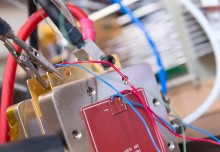

News in brief
Hydrogen fuel breakthrough prize and barcoding parasites: News from the College
Here’s a batch of fresh news and announcements from across Imperial.



Hydrogen fuel breakthrough prize and barcoding parasites: News from the College
Here’s a batch of fresh news and announcements from across Imperial.


Partnership targets radical transformation of process manufacturing
Imperial and China’s Jiangsu Industrial Technology Research Institute (JITRI) have launched a new partnership on intelligent process manufacturing.


Carbon captured and stored since 1996 is significant but overestimated
Although a significant amount of carbon has been caught and stored so far, governments should curb overestimation with reporting frameworks.


Imperial and Hitachi to launch decarbonisation research centre
A new joint research centre to tackle key challenges in decarbonisation and climate repair is to be launched by Imperial College London and Hitachi.


Partnership with Imperial battery startup enhances VARTA’s performance
A partnership with Breathe Battery Technologies is raising the performance of VARTA’s batteries for automated guided vehicles and other applications.


Tech entrepreneurs join forces to invest in Imperial battery startup
Imperial’s startup ecosystem has helped connect About:Energy with the investment it needs to rise to the next level.


Meet the women breaking new ground in the power sector
Women are underrepresented in the global power sector, but the industry is changing for the better, according to some of its leading engineers.


Green city sparks imagination of young festival-goers
From pedal power to magnetic trains, young visitors to the Great Exhibition Road Festival were brimming with ideas for powering low-carbon cities.


Biogas and biomethane supply chains contribute much to global methane emissions
A new Imperial analysis has found that biogas and biomethane, while more climate friendly, leak up to twice as much methane as previously thought.


Ultrafast lasers used to probe next-generation solar cells
Researchers have tracked the first fractions of a second after light strikes solar cells, providing insights into how they produce electricity.
 1
1